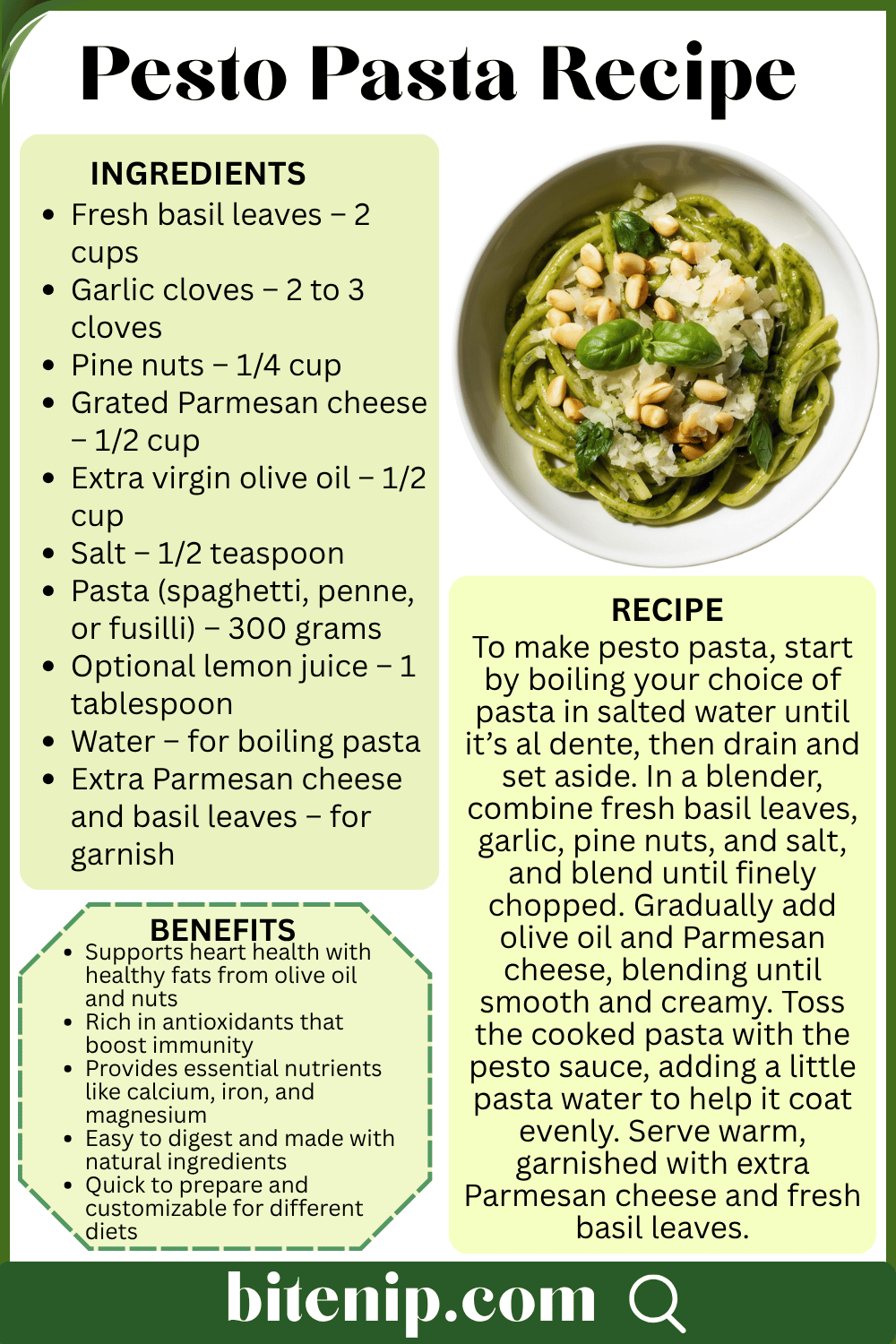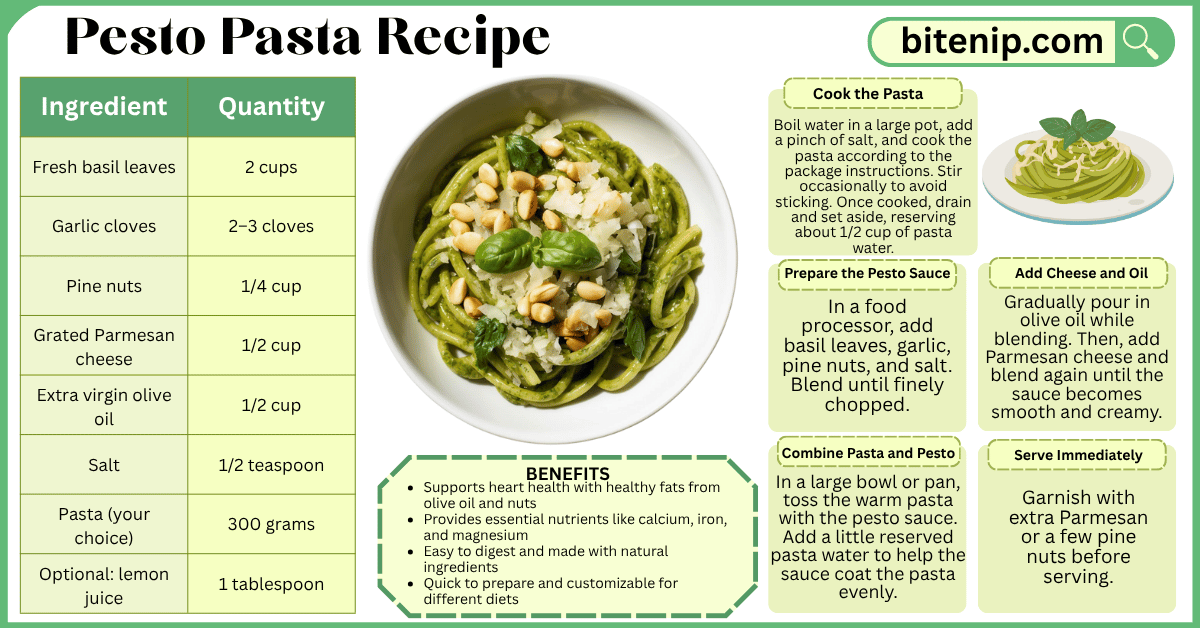Pesto Pasta Recipe is a flavorful Italian dish that combines the freshness of basil, the richness of olive oil, and the creaminess of cheese with perfectly cooked pasta. It’s quick to prepare, satisfying, and can be served hot or cold. Many people enjoy it as a light lunch or dinner, and some even eat it chilled as a pasta salad. However, pesto pasta is not technically a salad—it’s a pasta dish that can be served like one because of its fresh, herb-based sauce.
Origin of Pesto Pasta
Pesto Pasta traces its roots back to Genoa, the capital of Italy’s Liguria region. The word “pesto” comes from the Italian verb pestare, meaning “to crush” or “to pound.” Traditionally, pesto was made using a mortar and pestle, where fresh basil leaves, garlic, pine nuts, and Parmesan cheese were ground together with olive oil. The resulting sauce was tossed with pasta, creating a dish that became famous worldwide for its simplicity and aromatic flavor.
Ingredients of Pesto Pasta Recipe with Pictures
- Basil Leaves
Fresh basil provides the distinct aroma and green color that defines pesto. It brings a slightly sweet and peppery flavor.

- Garlic
Adds depth and a hint of spice to balance the freshness of the basil.
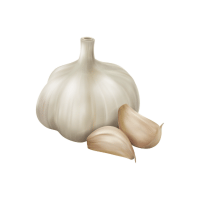
- Pine Nuts
These nuts offer a buttery texture and mild nutty flavor that thickens the sauce.

- Parmesan Cheese
Gives a salty, umami taste and creamy consistency to the pesto.
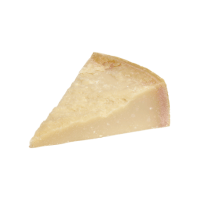
- Olive Oil
Binds all the ingredients together while adding richness and smoothness.
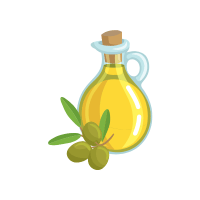
- Salt
Enhances all the other flavors without overpowering them.

- Pasta (Spaghetti, Penne, or Fusilli)
Acts as the base that absorbs the pesto sauce perfectly.
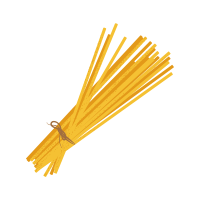
Ingredients with Quantity
| Ingredient | Quantity |
|---|---|
| Fresh basil leaves | 2 cups |
| Garlic cloves | 2–3 cloves |
| Pine nuts | 1/4 cup |
| Grated Parmesan cheese | 1/2 cup |
| Extra virgin olive oil | 1/2 cup |
| Salt | 1/2 teaspoon |
| Pasta (your choice) | 300 grams |
| Optional: lemon juice | 1 tablespoon |
Step by Step Pesto Pasta Recipe
-
Cook the Pasta:
Boil water in a large pot, add a pinch of salt, and cook the pasta according to the package instructions. Stir occasionally to avoid sticking. Once cooked, drain and set aside, reserving about 1/2 cup of pasta water. -
Prepare the Pesto Sauce:
In a food processor, add basil leaves, garlic, pine nuts, and salt. Blend until finely chopped. -
Add Cheese and Oil:
Gradually pour in olive oil while blending. Then, add Parmesan cheese and blend again until the sauce becomes smooth and creamy. -
Combine Pasta and Pesto:
In a large bowl or pan, toss the warm pasta with the pesto sauce. Add a little reserved pasta water to help the sauce coat the pasta evenly. -
Serve Immediately:
Garnish with extra Parmesan or a few pine nuts before serving.
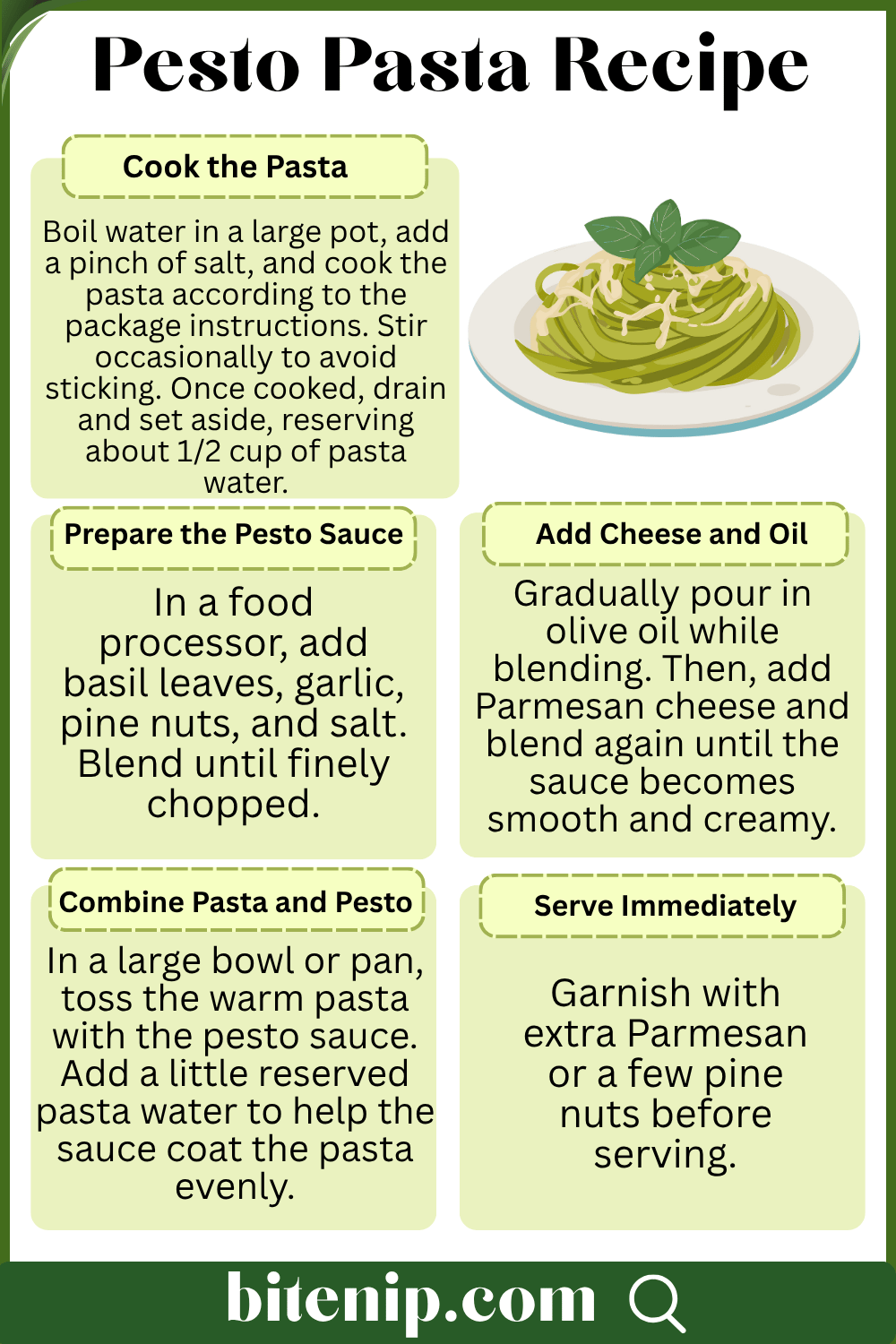
Common Mistakes to Avoid
-
Overcooking the Pasta:
Soft, mushy pasta ruins the texture. Always cook it al dente (firm to the bite). -
Using Old Basil:
Wilted basil makes the sauce bitter. Fresh, green leaves are essential for vibrant color and flavor. -
Skipping Pasta Water:
The starchy water helps the pesto stick to the pasta. Without it, the sauce might feel dry. -
Over-blending the Sauce:
Blending too long warms the basil and darkens the color. Pulse instead of blending continuously.
Tips for Perfect Pesto Pasta Recipe
-
Chill Ingredients Before Blending:
This keeps the basil green and prevents the sauce from overheating. -
Toast Pine Nuts:
Lightly toasting them enhances the flavor and adds a pleasant crunch. -
Add Lemon Juice:
A splash of lemon juice brightens the flavor and prevents the basil from turning brown. -
Use High-Quality Olive Oil:
The better the oil, the richer and smoother the sauce.
Variations of Pesto Pasta Recipe
-
Creamy Pesto Pasta:
Mix the pesto with a bit of cream or cream cheese for a velvety version. -
Vegan Pesto Pasta:
Replace Parmesan with nutritional yeast and skip the cheese entirely for a dairy-free option. -
Chicken Pesto Pasta:
Add grilled chicken pieces for extra protein and a hearty meal. -
Tomato Pesto Pasta:
Blend in a few sun-dried tomatoes with the basil to create a tangy twist.
Serving Suggestions
Pesto pasta pairs beautifully with garlic bread, grilled vegetables, or a light salad on the side. You can also serve it chilled for a summer meal, making it perfect for picnics or quick lunches. A sprinkle of cheese and a drizzle of olive oil on top make it look and taste restaurant-worthy.
Nutritional Information
| Nutrient | Per Serving (1 cup) |
|---|---|
| Calories | 450 kcal |
| Protein | 12 g |
| Carbohydrates | 48 g |
| Fat | 22 g |
| Fiber | 3 g |
| Sodium | 380 mg |
| Calcium | 90 mg |
Why People Love It ?
People love Pesto Pasta because it’s simple, fresh, and full of flavor. It’s versatile—you can enjoy it warm or cold, as a main course or a side dish. Moreover, the blend of basil, cheese, and garlic creates a comforting aroma that instantly lifts your mood.
Benefits of Pesto Pasta Recipe
1. Rich in Healthy Fats
Pesto pasta contains olive oil and pine nuts, both of which are excellent sources of monounsaturated fats. These fats help lower bad cholesterol (LDL) and support heart health. They also provide lasting energy, making the dish both satisfying and nutritious.
2. Packed with Antioxidants
Fresh basil—the key ingredient in pesto—is loaded with antioxidants like beta-carotene and flavonoids. These compounds help reduce inflammation, protect cells from damage, and support a healthy immune system.
3. High in Essential Nutrients
Pesto pasta offers calcium and protein from Parmesan cheese, iron from basil, and magnesium from nuts. These nutrients play a key role in maintaining bone strength, muscle health, and energy production.
4. Supports Digestive Health
Because it uses olive oil and natural ingredients, pesto pasta is easier to digest than cream-based sauces. Olive oil also aids digestion and promotes a healthy gut environment.
5. Quick and Convenient Meal
This dish is simple and fast to prepare. You can make it in under 20 minutes, making it perfect for busy schedules while still offering a homemade, flavorful meal.
6. Versatile and Customizable
You can easily adapt pesto pasta to your diet. Whether you’re vegetarian, vegan, or gluten-free, it’s simple to adjust the ingredients without losing its signature taste.
7. Boosts Mood and Energy
The aroma of fresh basil and garlic stimulates the senses, while the carbohydrates from pasta provide quick energy. Together, they make for a feel-good meal that leaves you both full and energized.
Disadvantages of Pesto Pasta Recipe
1. High in Calories
Pesto pasta can be calorie-dense because of the olive oil, cheese, and nuts used in the sauce. Regular consumption without portion control may lead to weight gain, especially if paired with other high-calorie foods.
2. Contains Allergens
This dish isn’t suitable for everyone. Pine nuts may trigger nut allergies, and Parmesan cheese contains dairy, which can be problematic for those who are lactose intolerant or allergic to milk products.
3. High in Fat Content
Although the fats in olive oil are healthy, eating too much can still add excess fat to your diet. Consuming large portions frequently might not be ideal for people on low-fat or weight-loss plans.
4. Short Shelf Life
Freshly made pesto sauce spoils quickly because it lacks preservatives. It can last only a few days in the fridge, and freezing it slightly changes the flavor and texture.
5. Not Suitable for Certain Diets
Traditional pesto contains cheese, which makes it unsuitable for strict vegans. Even when adapted, the flavor might differ from the original, which can be a drawback for purists.
6. Sodium Content
Parmesan cheese and added salt can increase the sodium level of the dish. Excess sodium intake can contribute to high blood pressure or other cardiovascular concerns if eaten too often.
7. Can Be Expensive to Prepare
Ingredients like pine nuts and quality olive oil can be pricey. If you’re cooking for a large group, making pesto pasta regularly can become a bit costly.
FAQS
1. Is pesto pasta a salad?
No, but it can be served cold like a pasta salad.
2. Can I use dried basil?
Fresh basil is preferred. Dried basil won’t give the same aroma or flavor.
3. How long does pesto last?
Fresh pesto lasts 3–4 days in the refrigerator.
4. Can I freeze pesto?
Yes, store it in an airtight container for up to 2 months.
5. What pasta works best?
Spaghetti, penne, or fusilli work best as they hold the sauce well.
6. Can I skip pine nuts?
Yes, you can use walnuts, almonds, or cashews instead.
7. Why did my pesto turn brown?
Overheating or too much blending can cause discoloration.
8. Can I make it vegan?
Yes, substitute Parmesan with nutritional yeast or vegan cheese.
9. What can I serve it with?
It pairs well with grilled chicken, shrimp, or roasted vegetables.
10. How can I make it healthier?
Use whole wheat pasta and reduce the amount of cheese and oil.
Conclusion
Pesto Pasta is a timeless Italian dish that balances flavor, freshness, and nutrition. With the right ingredients and a few simple techniques, you can create a meal that’s both comforting and elegant. Whether you enjoy it warm or cold, this dish is sure to please your taste buds and impress anyone at your table. And while it may look like a salad when chilled, it’s truly a pasta classic loved around the world.
